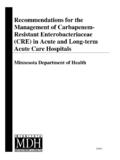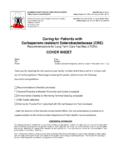Transcription of Laboratory Detection and Reporting of CRE - …
1 Laboratory Detection and Reporting of CREJune 6, 2014 Featured PresentersThe opinions, viewpoints, and content presented in this webinar may not represent the position of the Illinois Department of Public HealthPaul C. Schreckenberger, , D(ABMM), F(AAM)Professor of Pathology Director, Clinical Microbiology LaboratoryLoyola University Medical CenterWilliam Trick, , Collaborative Research UnitCook County Health & Hospitals SystemMichael Lin, , Professor, Infectious DiseasesRush University Medical CenterPaul C. Schreckenberger, , D(ABMM), F(AAM)Professor of PathologyDirector, Clinical Microbiology LaboratoryLoyola University Medical Department of Public Health, Division of Patient Safety and QualityJune 6, 2014 Laboratory Detection and Reporting of CREL earning ObjectivesAt the conclusion of this Session, participants will be able mechanisms of carbapenem resistance criteria to be used for screening Laboratory isolates for the procedure, interpretation and application of the Hodge Test and MBL the pitfalls of susceptibility testing for the Detection of appropriate comments for Reporting CRE4 Financial Disclosures5 Type of Affiliation/Financial InterestName of Commercial InterestSalaried EmployeeLoyola University Medical CenterStocks/Stock OptionsNoneIndependent contractor/Speaker s BureaubioMerieux, Cubist, Forest Laboratories, Hardy Diagnostics, Merck, Remel, SiemensConsultant/Advisory CommitteesAbbott Molecular, BioFire.
2 Forest Laboratories, Quidel, Thermo Fisher Scientific, TheravanceResearch GrantsAbbott Molecular, Becton-Dickinson, BioFire, bioMerieux, Cepheid, SiemensPenicillin nucleusCOOHORSCH3CH3N123456713 Cephalosporin nucleusCOHN1SR1R2 OCOOH76 The -lactam family of antibioticsCeftriaxone 3rdTicarcillinCeftazidime 3rdMezlocillinCefotaxime 3rdCarbenicillinErtapenemCefmetazoleCefu roxime 2ndAmpicillinMeropenemCefotetanCefamando le 2ndMethicillinAztreonamImipenemCefoxitin Cephalothin 1stBenzyl-penicillinMonobactamsCarbapene msCephamycinsCephalosporinsPenicillinsCe fepime 4thDoripenem7 MODE OF ACTION OF BETA LACTAMS IN GRAM NEGATIVESSUSCEPTIBLE -Lactam Antibiotic Diffusion throughOuter Membrane Diffusion throughPeptidoglycan Penicillin Binding Proteins Cell Death8 RESISTANT Porin Blocks Entry Efflux Pump Beta-LactamaseHydolyzes Beta-Lactam Changes in PBP results in Failure to Bind to -LactamThe -lactam family of antibioticsCeftriaxone 3rdTicarcillinCeftazidime 3rdMezlocillinCefotaxime 3rdCarbenicillinErtapenemCefmetazoleCefu roxime
3 2ndAmpicillinMeropenemCefotetanCefamando le 2ndMethicillinAztreonamImipenemCefoxitin Cephalothin 1stBenzyl-penicillinMonobactamsCarbapene msCephamycinsCephalosporinsPenicillinsCe fepime 4thESBLs hydrolyze all PenicillinsCephalosporinsMonobactamsDori penem9 The -lactam family of antibioticsCeftriaxone 3rdTicarcillinCeftazidime 3rdMezlocillinCefotaxime 3rdCarbenicillinErtapenemCefmetazoleCefu roxime 2ndAmpicillinMeropenemCefotetanCefamando le 2ndMethicillinAztreonamImipenemCefoxitin Cephalothin 1stBenzyl-penicillinMonobactamsCarbapene msCephamycinsCephalosporinsPenicillinsCe fepime 4thampCs hydrolyze allPenicillinsCephalosporins except4thgeneration (cefepime)CephamycinsMonobactamsDoripene m10 The -lactam family of antibioticsCeftriaxone 3rdTicarcillinCeftazidime 3rdMezlocillinCefotaxime 3rdCarbenicillinErtapenemCefmetazoleCefu roxime 2ndAmpicillinMeropenemCefotetanCefamando le 2ndMethicillinAztreonamImipenemCefoxitin Cephalothin 1stBenzyl-penicillinMonobactamsCarbapene msCephamycinsCephalosporinsPenicillinsCe fepime 4thMetallo BL hydrolyze allPenicillinsCephalosporins CephamycinsCarbapenemsDoripenem11 The -lactam family of antibioticsCeftriaxone 3rdTicarcillinCeftazidime 3rdMezlocillinCefotaxime 3rdCarbenicillinErtapenemCefmetazoleCefu roxime 2ndAmpicillinMeropenemCefotetanCefamando le 2ndMethicillinAztreonamImipenemCefoxitin Cephalothin 1stBenzyl-penicillinMonobactamsCarbapene msCephamycinsCephalosporinsPenicillinsCe fepime 4thKPCs hydrolyze allPenicillinsCephalosporins CephamycinsCarbapenemsMonobactamsDoripen em1213 Carbapenems By way of review the following
4 Antibiotics are classified as carbapenems Ertapenem Doripenem Imipenem Meropenem14 Two mechanisms of resistance Carbapenemase( -lactamase that can hydrolyze carbapenems) Cephalosporinasecombined with porin loss Some cephalosporinases ( , AmpC-type -lactamases or certain ESBLs CTX-M) have a low-level carbapenemase activity Porin loss limits entry of the carbapenem into the periplasmic spaceCarbapenem-Resistance in EnterobacteriaceaeNeed to Distinguish Between Mechanisms of carbapenem Resistance Why? Carbapenemase Isolate likely to be resistant to all carbapenems and other -lactam agents May need to change susceptible reports to resistant for -lactam drugs Need to implement infection control measures such as contact precautions and possibly active surveillance testing These are an Infection Control Emergency15 Need to Distinguish Between Mechanisms of carbapenem Resistance Why? Cephalosporins combined with porin-loss Class A ESBL s (CTX-M) + reduced permeability Class C High AmpC + reduced permeability These hydrolyze ertapenem more than meropenem or imipenem Not necessarily resistant to all carbapenems ( , would not need to change susceptible results to resistant reports for b-lactam drugs These isolates are clearly MDR and infection control measures are recommended.)
5 Healthcare institutions may reserve more aggressive measures for carbapenemase-producing isolates16 MolecularClassCarbapenemaseFound in:Some Key FeaturesA KPCK. pneumoniaeand other EnterobacteriaceaeSome are chromosomal (NmcA, Sme, IMI-1, SFC-1) others are plasmid encoded (KPC, IMI-2, GES). All hydrolyze carbapenems and are partially inhibited by clavulanic acidSMES. marcescensalso IMI, NMCA, GESE nterobacteriaceaeBMetallo beta-lactamases(IMP, VIM, GIM, SPM, NDM-1)S. maltophiliaP. aeruginosa, Enterobacteriaceae,Acinetobacter, Hydrolyze all -lactams except aztreonam. Activity inhibited by EDTAbut not by clavulanic acidDOXAA cinetobacter baumannii, EnterobacteriaceaeOXA-48 first reported in Turkey in 2003. Not inhibited by EDTA or clavulanic acidAdapted from Queenan & Bush. 2007. Clin Microbiol Rev. 20 in the to Suspect a Carbapenemase Enterobacteriaceae especially K. pneumoniae that are resistant to extended-spectrum cephalosporins.
6 Carbapenemase-producing Enterobacteriaceae test resistant to extended-spectrum cephalosporins KPC producers show variable susceptibility to cefotetan, cefoxitin, and cefepime Metallo- -lactamas producers show variable susceptibility to aztreonam19 Strategy for Laboratory Detection of Carbapenemases CLSI Screening Criteria for KPCs (M100-S-19 Jan 2009) Disk zone of <22 mm for ertapenem or meropenem MIC of >1 g/ml for imipenem, ertapenem or meropenem CLSI Confirmatory Test (M100-S19, Jan 2009) Modified Hodge Test Procedure Notes Imipenem disk test is nota good screen Imipenem MIC does notwork as a screen for Proteus/Providencia/Morganelladue to slightly elevated MICs in this group20 Ertapenem Etest showing many break-through coloniesImipenem disk showing susceptible zone but many break-through colonies20 CefotaximeCeftazidimeImipenemErtapenemCe foxitinCefepimeCeftriaxoneAztreonamCefta zidime/CLAC efotaxime/CLAM odified Hodge Test Inoculate MH agar with a 1:10 dilution of a McFarland suspension of E.
7 ColiATCC 25922 and streak for confluent growth using a swab. Place 10- g ertapenem or meropenem (best)disk in center Streak each test isolate from disk to edge of plate Isolate A is a KPC producer and positive by the modified Hodge KF et al. JCM 2007 Aug;45(8):2723-5. 21 Carba NP Test for Carbapenemase Production Isolated colonies (lyse / centrifuge) Hydrolysis of imipenem Detected by change in pH of indicator (red to yellow/orange) Rapid <3h Microdilution plate or microtube methodNordmann et al. 2012. Emerg Infect Dis. 18 et al. 2013. Antimicrob Agent Chemo. 57 et al. 2013. J Clin Microbiol. 51:3092. a tubes Solution A b tubes Solution A + imipenem22(slide courtesy Janet HindlerEPI-CRE Pilots Point, Sarasota, FL 23 Rosco Diagnostica IMI/EDTA DisksMBL Etest bioMerieuxIMI + EDTA = 27 mmIMI alone =19 mmEDTA Etest = PosMeropenem Etest24 KPC -Questions If I have detected KPC-production, should I change susceptible carbapenem results to resistant?)
8 If using oldCLSI carbapenem breakpoints: Isolates that are MHT positive and have an ertapenem MIC of 2-4 ug/mL,imipenem MIC of 2-8 ug/mL, or meropenem MIC of 2-8 ug/mL, Report carbapenems as resistant If using newCLSI carbapenem breakpoints Report MIC, interpret with new breakpoints(CLSI Jan 2011 M100-S21, p. 55)25 Enterobacteriaceae -Revised carbapenem Breakpoints (MIC )AgentCLSI M100-S19 (2009)CLSI M100-S20-U (2010) SupplementSuscIntResSuscIntResDoripenem- -- 12 4 Ertapenem* 24 8 2 Imipenem 48 16 12 4 Meropenem 48 16 12 4 CLSI M100-S20-U. Table 2 ASpecial CLSI M100-S20-U Supplement published June 2010 with Enterobacteriaceae Tables with these new breakpoints26* Ertapenem BP revised in CLSI document M100-S22 Jan 2012 Enterobacteriaceae -Revised carbapenem Breakpoints (disk mm)AgentCLSI M100-S19 (2009)CLSI M100-S20 (2010)SuscIntResSuscIntResDoripenem--- 2320-22 19 Ertapenem* 1916-18 15 2219-21 18 Imipenem 1614-15 13 2320-22 19 Meropenem 1614-15 13 2320-22 1927 Special CLSI M100-S20-U Supplement published June 2010 with Enterobacteriaceae Tables with these new breakpoints* Ertapenem BP revised in CLSI document M100-S22 Jan 2012 CLSI M100-S20-U.
9 Table 2A28 Why is carbapenem Resistance a Public Health Problem? Significantly limits treatment options for life-threatening infections No new drugs for gram-negative bacilli Emerging resistance mechanisms, carbapenemases are mobile Detection of carbapenem Resistant Enterobacteriacea (CRE) and implementation of infection control practices are necessary to limit spreadCDC Definition of CRE( carbapenem Resistant Enterobacteriaceae) Enterobacteriaceae that are: Nonsusceptibleto one of the following carbapenems: doripenem, meropenem, or imipenem AND Resistantto all of the following 3rd-generation cephalosporins that were tested: ceftriaxone, cefotaxime, and ceftazidime. (Note: All three of these antimicrobials are recommended as part of the primary or secondary susceptibility panels for Enterobacteriaceae) Definition of CRE Klebsiella E. colithat meet the CRE definition are a priority for Detection and containment in all settings; however, other Enterobacteriaceae( , Enterobacterspecies) might also be important in some regions.
10 For bacteria that have intrinsic imipenem nonsusceptibility ( , Morganella morganii, Proteusspp., Providenciaspp.), requiring nonsusceptibility to carbapenems other than imipenem as part of the definition might increase vs. Proteeae MIC90S of imipenem are 1 ug/mL for most Enterobacteriaceae, but are 4-8 ug/mL for Proteeae and therefore may test non-susceptible to imipenem using the new CLSI/FDA breakpoints Some P. mirabilis are more resistant, with imipenem MICs ranging from 16 to 64 ug/mL Higher MICs seen with imipenem vs. P. mirabilis are not due to carbapenemases but rather diminished expression of penicillin-binding protein (PBP) 1a and reduced binding of imipenem by PBP2 Meropenem, doripenem and ertapenem are not affected and will test in susceptible range in absence of a carbapenemase (eg. KPC) 31 Villar HE et al JAC 1997, 40:365-370 Neuwirth C, et al. 1995, 36:335-342 Imipenem Disclaimers FDA Indications for imipenem: Acinetobacterspp.




